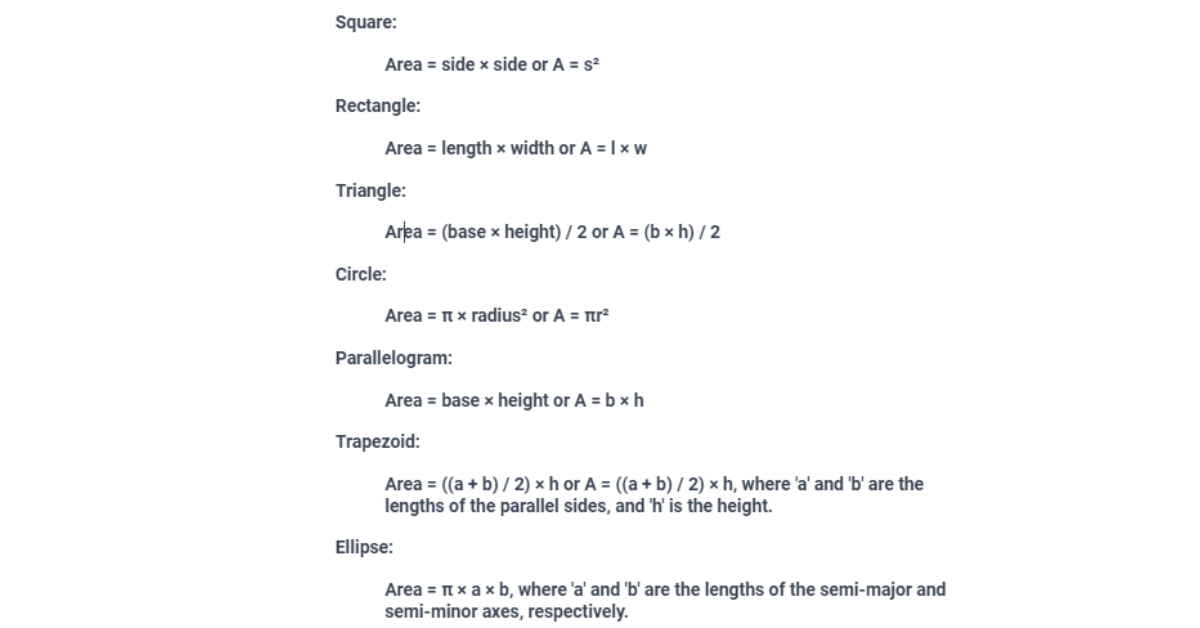Introduction
In the vast landscape of mathematics, the concept of area holds a pivotal role. Whether you’re an aspiring mathematician or someone looking to understand the practical applications of mathematical formulas, exploring how to find area is a fascinating journey.
What is Area?
Area, in simple terms, refers to the measure of the extent of a 2D shape. It provides valuable information about the space a shape occupies, making it a fundamental concept in geometry. Understanding the concept of area is crucial for various fields, from construction to art and beyond.
The formula for finding the area of different geometric shapes is as follows:
Square:
- Area = side × side or A = s²
Rectangle:
- Area = length × width or A = l × w
Triangle:
- Area = (base × height) / 2 or A = (b × h) / 2
Circle:
- Area = π × radius² or A = πr²
Parallelogram:
- Area = base × height or A = b × h
Trapezoid:
- Area = ((a + b) / 2) × h or A = ((a + b) / 2) × h, where ‘a’ and ‘b’ are the lengths of the parallel sides, and ‘h’ is the height.
Ellipse:
- Area = π × a × b, where ‘a’ and ‘b’ are the lengths of the semi-major and semi-minor axes, respectively.
These are some of the common formulas for finding the area of various geometric shapes. Remember to use the appropriate formula based on the shape you are dealing with.
Common 2D Shapes
Before delving into the intricacies of area formulas, let’s acquaint ourselves with some common 2D shapes. From squares and rectangles to triangles and circles, each shape has its unique way of contributing to our understanding of space.
Area of Squares and Rectangles
Among the simplest shapes, squares and rectangles have straightforward area formulas. The area of a square is determined by multiplying the length of one side by itself, while the area of a rectangle involves multiplying its length and width. These formulas find applications in everyday scenarios, from calculating carpet size to determining the space needed for a bookshelf.
Area of Triangles
Triangles add a layer of complexity to area calculations. The area of a triangle can be found using the formula (1/2) × base × height. This formula comes to life with practical examples, illustrating the importance of height in determining the area of a triangle.
Area of Circles
Circles, with their constant curvature, have a unique formula for calculating area. The area of a circle is given by π × radius squared. Visualizing this formula helps in grasping the concept of area for circular shapes and their real-world applications.
Special Shapes and their Area
Not all shapes fit into standard formulas. Irregular shapes require creative strategies to calculate their area. Understanding the perimeter and breaking down the shape into simpler components are essential techniques for finding the area of irregular shapes.
Importance in Daily Life
The applications of area in our daily lives are myriad. From calculating the area of a room for flooring to determining the amount of paint needed for a wall, a grasp of area concepts is invaluable in various practical scenarios.
Tips and Tricks for Quick Calculations
For those seeking efficiency in mathematical calculations, there are shortcuts for finding the area of common shapes. These tips not only save time but also enhance the overall mathematical experience.
Common Mistakes in Area Calculations
Even the most seasoned mathematicians can make mistakes. Addressing common errors in area calculations and providing tips for avoiding them ensures more accurate and reliable results.
Perplexity in Area Problems
As we navigate through mathematical problem-solving, we encounter moments of perplexity. Complex area questions may seem daunting, but understanding the challenges and employing systematic approaches can unravel even the most intricate problems.
Burstiness in Mathematical Concepts
Burstiness, a concept often associated with data, can be applied to mathematical problem-solving. Embracing burstiness in understanding mathematical concepts allows for creative thinking and novel approaches to problem-solving.
Engaging the Reader
Making mathematics interesting is an art. Techniques such as incorporating curiosity, asking rhetorical questions, and using relatable examples keep the reader engaged, fostering a deeper appreciation for the subject.
Conclusion
In the vast realm of mathematics, understanding how to find area is not just a matter of calculations; it’s a journey that unveils the mysteries of spatial measurement. From the simplicity of squares to the curvature of circles, each shape contributes to the richness of mathematical understanding. As we conclude our exploration, remember that mathematics is not just about numbers; it’s a language that describes the world around us in fascinating ways.
FAQs
How can I quickly calculate the area of a square?
To find the area of a square, simply multiply the length of one side by itself.
Are there any real-life applications for knowing the area of a circle?
Absolutely! Knowing the area of a circle is crucial for various applications, from calculating the space in a circular garden to determining the material needed for a circular tablecloth.
What are the common mistakes to avoid when finding the area of a triangle?
A common mistake is forgetting to use the height in the formula. Always ensure you have the correct base and height values.
Can burstiness be applied to other mathematical problems?
Burstiness, when applied creatively, can enhance problem-solving in various mathematical contexts. It encourages thinking outside the traditional mathematical frameworks.
Where can I find more resources for improving my math skills?
There are numerous online platforms, educational websites, and community forums dedicated to improving math skills. Explore these resources to expand your mathematical knowledge.




